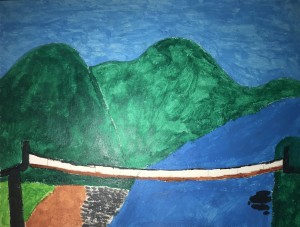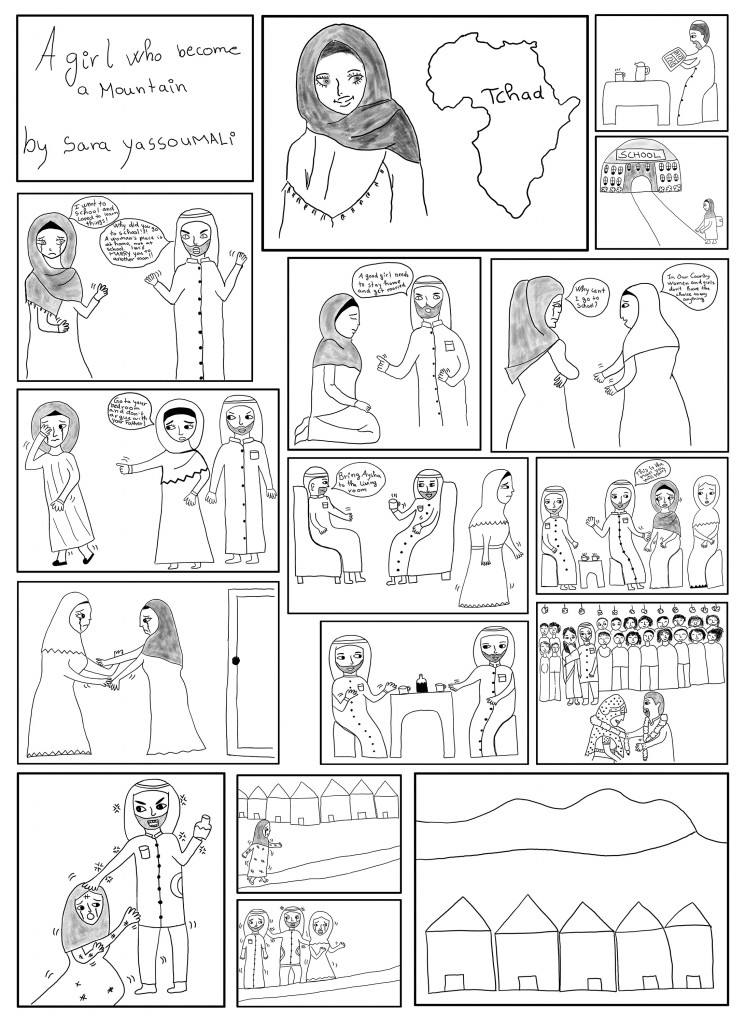AURORA’s Latest Project Spotlights Dallas Teens’ Stories About Migration
ArtandSeek.net January 21, 2021 24AURORA, the Dallas-based public arts organization, is known for its light, video and sound projections on and near buildings around Dallas. But its latest project is shining a light on the migration experiences of teens.
Rather than one large event that happens on just one night, AURORA’s biennial for 2020-21 is instead decentralizing and rolling out their projects over time.
Their latest 3-part project called Remote Pyramids takes a deep dive into the topic of immigration by connecting a group of resettled refugee teenagers from the Vickery Meadow neighborhood in Dallas with a group of teens from Oak Cliff with their own immigration experiences.

The River by Alexander Lopez, 2021, Acrylic on paper, 10” x 20”
AURORA Biennial curator Noam Segal tapped Chicago-based artist and educator Jan Tichy for the project. Tichy modeled Remote Pyramids after his 2017 project Beyond Streaming: Sound Mural for Flint in Michigan – which brought together teens from water-poisoned Flint with young people in the state capital of Lansing. Through collaboration, the two groups developed content for an exhibition at the Eli and Edythe Broad Museum in Lansing and built greater awareness to the Flint water crisis.
The framework for Remote Pyramids began last year, when Tichy collaborated with North Texas educators, activists, artists and cultural practitioners to bring teen artists together for the Remote AURORA Summer Art Workshop. These particular students participated because of their personal connections with immigration.

‘Look Up’ by Sumaya Sakhi 2021, vinyl cut out, 20*40 inches
The young artists—Josafat Delgado, Alexander Lopez, and Andrez Rivas from Molina High School, and Judy Kharchou, Sumaya Sakhi and Sara Yassoumali from Lake Highlands High School—met via zoom to discuss history and the way it’s celebrated. The group proposed new monuments for public spaces in Dallas communities. And they posed questions to Dallas Mayor Eric Johnson about poverty, policing, the environment and heritage.
To tell their stories of migration, the teen artists chose a variety of different media.
- Alexander Lopez and Andrez Rivas’ mural concept deals with migration in the Hispanic culture.
- Judy Kharchou told her story of migration from Damascus to Dallas with watercolors and stop motion animation in a short film.
- Josefat Delgado uses a series of cutouts to illustrate the five journeys of his family from Mexico.
- Sumaya Sakhi created a poster using henna painting techniques. It was inspired by the comfort spirituality brought to her while growing up in Pakistan.
- And Sara Yassoumali created a comic strip that tells the story of a child marriage in the country of Chad.
The student’s artwork for Remote Pyramids is being rolled out in three parts:
- A web site: At remotepyramids.org visitors can learn about the history of the project, read bios about the young artists and view their resulting public art works.
- Installations at Oak Cliff Cultural Center: The teens’ works will be on view at the Center from January 23–March 6. The installations can be seen through the windows and storefront of the Center allowing for social distancing.
- A video projection by Jan Tichy: On January 23, Tichy’s light projection will be shown at Dallas City Hall. The projection artistically ties together the students’ artwork and their questions for the mayor. Dallas City Hall’s inverted pyramid shape makes it an ideal canvas for the projection.

A Girl Who Became a Mountain by Sara Yassoumali, 2021, Pencil on paper, 8*10 inch
Monica Salazar, AURORA Director of Programming, notes that the group is presenting the AURORA Biennial in this format because of the pandemic.
“Our aim is to return to our centralized, large-scale biennial event that takes place downtown when conditions are safe to do this again,” said Salazar. “In addition to the Biennial event, going forward, we will present our year-round AURORA Expanded programming (focused on supporting and spotlighting regional artists) and our Artist Relief Fund grant.”
Remote Pyramids is part of “Afterwards was already before,” AURORA’s fifth biennial, curated by Noam Segal and Associate Curators Tamara Johnson and Trey Burns. The local artistic practitioners Jin-Ya Huang, Eva Arreguin, Sara Mokuria, Sophie Lopez, Nura Husseini and Giovani Valderas worked with the young artists Josafat Delgado, Alexander Lopez, Andrez Rivas, Judy Kharchou, Sumaya Sakhi and Sara Yassoumali during this project. The educators in the Remote AURORA Summer Art Workshop were Maria Viera-Williams, Laura Quintero and Jan Tichy.
Got a tip? Email Therese Powell at tpowell@kera.org. You can follow her on Twitter @TheresePowell13
Art&Seek is made possible through the generosity of our members. If you find this reporting valuable, consider making a tax-deductible gift today. Thank you










